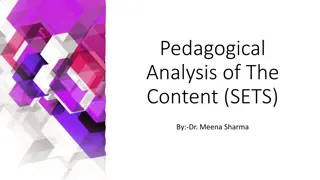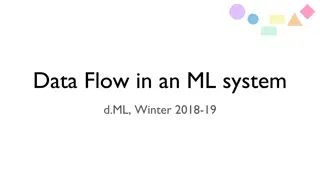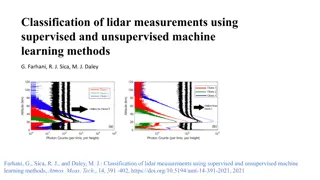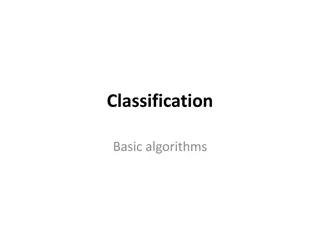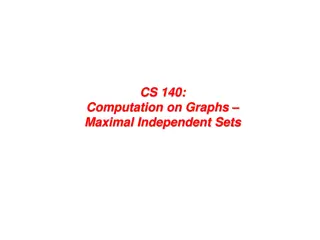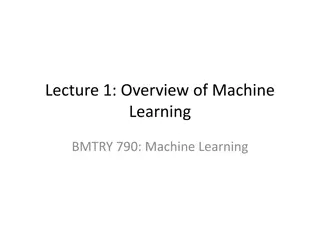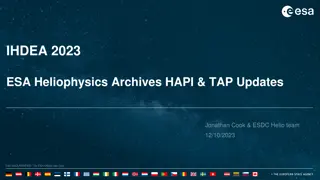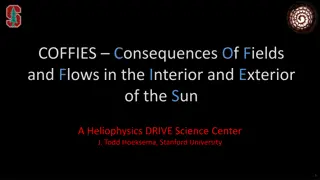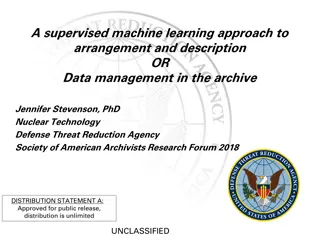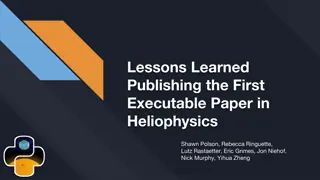Machine Learning-Ready Data Sets in Heliophysics
This presentation by Viacheslav (Slava) Sadykov explores the importance of Machine Learning-Ready Data Sets in Heliophysics, highlighting key principles and examples. It delves into data preparation challenges in machine learning, emphasizing the significance of clean, complete, and accessible data sets for effective research.
Download Presentation

Please find below an Image/Link to download the presentation.
The content on the website is provided AS IS for your information and personal use only. It may not be sold, licensed, or shared on other websites without obtaining consent from the author. Download presentation by click this link. If you encounter any issues during the download, it is possible that the publisher has removed the file from their server.
E N D
Presentation Transcript
Machine Learning-Ready Data Sets in Heliophysics Viacheslav (Slava) Sadykov Georgia State University, Atlanta, GA, USA IHDEA Meeting 2023 10/12-10/13, 2023, JHU/APL, Laurel MD
Outline Introduction to Machine Learning-Ready Data Sets Why do we need such data sets in Heliophysics? Key Principles Behind ML-Ready Data Sets Examples of ML-Ready Data Sets in Heliophysics (Very Subjective Selection) Historic examples of data sets Current examples and related research Highlighting Common Denominator Open Discussion
Two Plots from NASA ADS Proxy for number of contributions in Heliophysics ( Heliophysics , Space Weather , etc, in the abstract) Same with machine learning keywords added ( Machine learning , Artificial intelligence , etc, in the abstract)
Data Preparation in Machine Learning Data preparation is a key challenge in machine learning: The typical number mentioned is that 80% of time goes to data preparation This steps includes data preprocessing and cleaning, data set partitioning, data normalization, etc. Data preparation is an unavoidable step in the machine learning research Garbage in garbage out Time partitioning in ML research Data preparation Machine learning
ML-Ready Data Sets How to make a salad? Find a salad recipe Make some shopping at the grocery store Order a salad kit online Preprocess the ingredients (wash them, cut them, etc) Make a salad (mix the ingredients or cook them if required) Enjoy!
Signatures of ML-Ready Data Sets Be accessible to the target users with no extra steps / contacts / (cost?) Accessibility Users are given access to the entire collection of data, not only a subset Completeness All pieces needed for the training/testing and understanding of the data are there Integrability The amount of data is sufficient for machine learning applications Sufficiency Data set is pre-processed, cleaned, the data are verified Cleanliness Ready to use for non-domain experts, i.e., the key domain knowledge is simplified Understandability Following Nita et al. 2022 (white paper), Masson et al. 2024 (ASR, under review)
Where to Find ML-Ready Data Sets? Heliophysics ML-Ready data sets are often stored in the general-purpose data repositories (like Harvard Dataverse, Zenodo, or even local repositories) In general, there are more specific repositories for ML research data set exist: Examples: UC Irvine Machine Learning Repository (https://archive.ics.uci.edu/), Kaggle (https://www.kaggle.com/), etc. User-maintained lists: Ryan McGranaghan s List of Curated / Challenge Data Sets: (https://github.com/rmcgranaghan/data_science_tools_and_resources/wiki/ Curated-Reference%7CChallenge-Data-Sets) Credits: https://archive.ics.uci.edu/
SDO Data Set (Galvez et al. 2019) A curated data set from the NASA Solar Dynamics Observatory (SDO) for 2010- 2018 observations Combines the data from all three instruments (HMI, AIA, EVE) with a unified cadence for all three and unified parameters for imaging instruments (512x512 with the fixed size of the Sun) Other corrections (removal of corrupted data, degradation for SDO/AIA, etc) is applied Observed VS predicted solar wind. Credits: Hemapriya and Saurabh (2021)
SWAN-SF (Angryk et al. 2020) Space Weather Analytics for Solar Flares (SWAN-SF) contains the properties of the magnetic field in solar active regions and used for solar flare prediction The flare locations are verified. The data set has 5 partitions ensuring the removal of the temporal coherence aspect and maintaining a comparable class-imbalance Great visibility outside of solar physics domain (18 vs 64) Credits: Angryk et al. (2020) Credits: Ahmadzadeh et al. (2021)
SOHO Data Set Tool (Shneider et al. 2021) Represents a Python tool for generating theAI/ML-ready data set using either SoHO MDI/EIT/LASCO or SDO HMI/AIA data Takes into account the instrument degradations, differences in the spatial resolutions, and time synchronization Used in several applications like Dst forecasting or sunspot detection and classification Examples of samples to be removed (such as the planetary transit times). Credits: Shneider et al. (2021)
GSEP (Rotti et al. 2022) Integrated Geostationary Solar Energetic Particle Events Catalog (GSEP) contains the time series data of 341 SEP events observed by GOES spacecraft series The metadata contains information about the associated events (CMEs and solar flares) Can be used to studying SEP events, their precursors, etc. Credits: Rotti et al. (2022)
DMSP Particle Precipitation (McGranaghan et al., 2020) Targeted at modeling electron particle precipitation from the magnetosphere to the ionosphere using the particle precipitation data obtained with 51 satellite years of the Defense Meteorological Satellite Program (DMSP) observations temporally aligned with the measurements of the solar wind and geomagnetic activity Credits: McGranaghan et al. 2021
Ionospheric Scintillations (McGranaghan et al. 2018) Measurements of the Canadian High Arctic Ionospheric Network (CHAIN) co-aligned with the solar wind and geomagnetic activity data and contains two partitions for the years 2015 and 2016 Comparison of the ionospheric scintillation predictions using the persistence and SVM models Credits: McGranaghan et al. 2018
Ongoing Data Set Preparation Efforts ML-ready data sets for prediction of the effective dose rate measurements in airplane flights ARMAS measurements during over than 1000 flights connected to the environmental properties (cosmic ray measurements, geomagnetic, solar wind and solar activity measurements) serving as targets The major challenge: sparsity of the airplane flight data ML-ready data set for identification and categorization of ion-kinetic instabilities in solar wind Ion velocity distribution functions, as well as their quantification in terms of statistical moments, from hybrid-PIC simulations, and related presence and category of the instability Example of the stable velocity distribution function for protons (left). Airplane flight radiation database structure (right).
Convergence and Divergence Converging points among the data sets: Distinguish themselves with respect to the general category of catalogs or data sets by having additional steps towards data preprocessing, data cleaning, normalization, partitioning, etc. Are usable for ML applications with the relatively light effort (on average) Diverging points among the data sets: Either have a relatively well-defined goal / target behing (SWAN-SF, Ionospheric scintillations, PrecipNet data set) or be of a general purpose in nature (SDO and SOHO data sets) Provision of the data set partitioning along with the dataset itself (the partitioning typically allows to take into account some domain knowledge) Differ significantly in data sizes (10 MB for GSEP data set, 6.5 TB for SDO data set) and data formats (a single CSV file VS FITS files for individual instances)
Links to Data Sets Ryan McGranaghan s List of Curated / Challenge Data Sets: https://github.com/rmcgranaghan/data_science_tools_and_resources/wiki/Curated- Reference%7CChallenge-Data-Sets Links to historic data sets: Solar flare prediction: https://archive.ics.uci.edu/dataset/89/solar+flare Ionosphere sensing: https://archive.ics.uci.edu/dataset/52/ionosphere Mentioned ML-ready data sets: SWAN-SF: https://dataverse.harvard.edu/dataset.xhtml?persistentId=doi:10.7910/DVN/EBCFKM SDO data set: https://purl.stanford.edu/nk828sc2920 SOHO ML tool: https://github.com/cshneider/soho-ml-data-ready GSEP: https://doi.org/10.7910/DVN/DZYLHK Ionospheric scintillations: https://dx.doi.org/10.6084/m9.figshare.6813131.v1 Particle precipitation: http://dx.doi.org/10.5281/zenodo.4281122
Literature List Nita et al. (2022), eprint arXiv:2203.09544 Galvez et al. (2019), The Astrophysical Journal Supplement Series, Volume 242, Issue 1, article id. 7, 11 pp. Angryk et al. (2020), Scientific Data, Volume 7, Issue 1, article id.227. Shneider et al. (2021), eprint arXiv:2108.06394 Rotti et al. (2022), The Astrophysical Journal Supplement Series, Volume 262, Issue 1, id.29, 10 pp. McGranaghan et al. (2018), Space Weather, 16(11), 1817 1846, doi:10.1029/2018SW002018 McGranaghan et al. (2021), Space Weather, 19(6), e2020SW002684
Open Discussion What makes the ML data sets specific? How SPASE could be used to describe ML-ready data sets?




